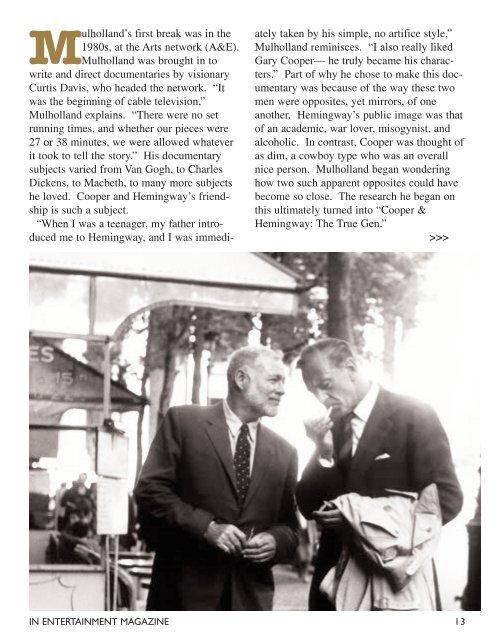ANNIVERSAY ISSUE 0717 ver2A
Create successful ePaper yourself
Turn your PDF publications into a flip-book with our unique Google optimized e-Paper software.
Mulholland’s first break was in the<br />
1980s, at the Arts network (A&E).<br />
Mulholland was brought in to<br />
write and direct documentaries by visionary<br />
Curtis Davis, who headed the network. “It<br />
was the beginning of cable television,”<br />
Mulholland explains. “There were no set<br />
running times, and whether our pieces were<br />
27 or 38 minutes, we were allowed whatever<br />
it took to tell the story.” His documentary<br />
subjects varied from Van Gogh, to Charles<br />
Dickens, to Macbeth, to many more subjects<br />
he loved. Cooper and Hemingway’s friendship<br />
is such a subject.<br />
“When I was a teenager, my father introduced<br />
me to Hemingway, and I was immediately<br />
taken by his simple, no artifice style,”<br />
Mulholland reminisces. “I also really liked<br />
Gary Cooper— he truly became his characters.”<br />
Part of why he chose to make this documentary<br />
was because of the way these two<br />
men were opposites, yet mirrors, of one<br />
another. Hemingway’s public image was that<br />
of an academic, war lover, misogynist, and<br />
alcoholic. In contrast, Cooper was thought of<br />
as dim, a cowboy type who was an overall<br />
nice person. Mulholland began wondering<br />
how two such apparent opposites could have<br />
become so close. The research he began on<br />
this ultimately turned into “Cooper &<br />
Hemingway: The True Gen.”<br />
>>><br />
IN ENTERTAINMENT MAGAZINE 13



